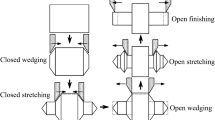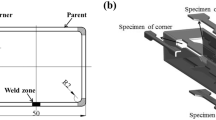Abstract
The accurate calculation of the spatial configuration of the tube billet in roll forming process is the theoretical premise of roll pass design. But the currently existing shape function method for calculating the spatial configuration cannot describe the springback of the tube billet after bending deformation, so it cannot be applied to the accurate calculation of the spatial configuration of high strength steel with large springback. For this reason, this paper derived the formulas for calculating the bending moment of springback, proposed a trajectory function G(X) to describe the deformation path of the points on the neutral layer of the tube billet in forming direction, and finally established a new method which is called trajectory function for calculating spatial configuration of high strength steel. To verify the accuracy of the trajectory function method, the ∅120 × 5-mm-high strength steel shaft tube roll forming process was taken as an example in this paper; the spatial configurations in five stages of the breakdown stage were obtained by experimental method, the trajectory function method, and the shape function method respectively. The calculated results of the trajectory function method were compared with those of the shape function method and the experimental method. The comparison shows that the results of the trajectory function method are closer to the experimental ones, and its overall accuracy is higher than that of the shape function method.
Similar content being viewed by others
References
Bui QV, Ponthot JP (2008) Numerical simulation of cold roll-forming processes. J Mater Process Technol 202:275–282
Farzin M, Tehrani MS, Shameli E (2002) Determination of buckling limit of strain in cold roll forming by the finite element analysis. J Mater Process Technol 125:626–632
Tehrani MS, Naeini HM, Hartley P, Khademizadeh H (2006) Localized edge buckling in cold roll-forming of circular tube section. J Mater Process Technol 177:617–620
Liu CF, Zhou WL, Fu XS, Chen GQ (2015) A new mathematical model for determining the longitudinal strain in cold roll forming process. Int J Adv Manuf Technol 79:1055–1061
Nefussi G, Gilormini P (1993) A simplified method for the simulation of cold-roll forming. Int J Mech Sci 35:867–878
Nefussi G, Proslier L, Gilormini P (1998) A simulation of cold-roll forming for elastoplastic materials. Int J Mech Sci 40:15–25
Nefussi G, Proslier L, Gilormini P (1999) Simulation of the cold-roll forming of circular tubes. J Mater Process Technol 95:216–221
Hong S, Lee S, Kim N (2001) A parametric study on forming length in roll forming. J Mater Process Technol 113:774–778
Heislitz F, Livatyali H, Ahmetoglu MA, Kinzel GL, Altan T (1996) Simulation of roll forming process with the 3-D FEM code PAM-STAMP. J Mater Process Technol 59:59–67
Abeyrathna B, Rolfe B, Hodgson P, Weiss M (2017) Local deformation in roll forming. Int J Adv Manuf Technol 88:2405–2415
Abeyrathna B, Rolfe B, Weiss M (2017) The effect of process and geometric parameters on longitudinal edge strain and product defects in cold roll forming. Int J Adv Manuf Technol 92:743–754
Rossi B, Degée H, Boman R (2013) Numerical simulation of the roll forming of thin-walled sections and evaluation of corner strength enhancement. Finite Elem Anal Des 72:13–20
Lindgren M (2007) Cold roll forming of a U-channel made of high strength steel. J Mater Process Technol 186:77–81
Kang W, Zhao Y, Yu W, Wang S, Ma Y, Yan P (2014) Numerical simulation and parameters analysis for roll forming of martensitic steel MS980. Procedia Eng 81:251–256
Paralikas J, Salonitis K, Chryssolouris G (2010) Optimization of roll forming process parameters-a semi empirical approach. Int J Adv Manuf Technol 47:1041–1052
Paralikas J, Salonitis K, Chryssolouris G (2011) Investigation of the effect of roll forming pass design on main redundant deformations on profiles from AHSS. Int J Adv Manuf Technol 56:475–491
Paralikas J, Salonitis K, Chryssolouris G (2009) Investigation of the effects of main roll-forming process parameters on quality for a V-section profile from AHSS. Int J Adv Manuf Technol 44:223–237
Yan Y, Wang H, Li Q (2014) Simulation and experimental verification of flexible roll forming of steel sheets. Int J Adv Manuf Technol 72:209–220
Han ZW, Liu C, Lu WP, Ren LQ (2001) The effects of forming parameters in the roll-forming of a channel section with an outer edge. J Mater Process Technol 116:205–210
Han ZW, Liu C, Lu WP, Ren LQ, Tong J (2005) Spline finite strip analysis of forming parameters in roll forming a channel section. J Mater Process Technol 159:383–388
Han ZW, Liu C, Lu WP, Ren LQ, Tong J (2004) Experimental investigation and theoretical analysis of roll forming of electrical resistance welded pipes. J Mater Process Technol 145:311–316
Zhou Y, Jiang WG, Liu C (1997) Analysis for roll forming processes by using the elastic-plastic spline finite strip method. Chin J Mech Eng 33:82–87
Liu C, Zhou Y, Lu W (1996) Numerical simulation of roll-forming by B-spline finite strip method. J Mater Process Technol 60:215–218
Wang J, Han B, Li D (2008) Progress of research on weld-pipe formation process with FE method. Steel Pipe 37:65–70
Bhattacharyya D, Smith PD, Yee CH, Collins IF (1984) The prediction of deformation length in cold roll-forming. J Mech Work Technol 9:181–191
Tafti RA, Naeini HM, Tehrani MS, Rolfe BF, Weiss M (2013) Theoretical extension of elastic-perfectly plastic deformation length in roll forming of a channel section. J Mater Process Technol 47:33–45
Kiuchi, M (1972) Analytical study on cold-roll forming process. Report of the Institute of Industrial Science, University of Tokyo
Duggal N, Ahmetoglu MA, Kinzel GL, Altan T (1996) Computer aided simulation of cold roll forming — a computer program for simple section profiles. J Mater Process Technol 59:41–48
Jiang H, Kiuchi M (1996) Computer aided simulation model for roll-forming processes. Iron Steel 31:40–45 (in Chinese)
Jiang H, Kiuchi M (1997) Computer aided simulation of roll-forming process for welded pipes. Iron Steel 32:38–43 (in Chinese)
Xue P, Yu TX, Chu E (2001) An energy approach for predicting springback of metal sheets after double-curvature forming, part I: axisymmetric stamping. Int J Mech Sci 43:1893–1914
Acknowledgements
The authors would like to acknowledge the financial support from the Independent Innovation and Achievement Transformation Program of Shandong Province of China (NO. 2014ZZCX09201).
Author information
Authors and Affiliations
Corresponding author
Rights and permissions
About this article
Cite this article
Zhang, W., Zhao, G., Zhai, Z. et al. Calculation method of spatial configuration of tube billet in roll forming process of a high strength steel drive shaft tube. Int J Adv Manuf Technol 97, 3339–3358 (2018). https://doi.org/10.1007/s00170-018-2209-1
Received:
Accepted:
Published:
Issue Date:
DOI: https://doi.org/10.1007/s00170-018-2209-1




